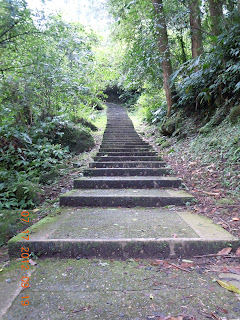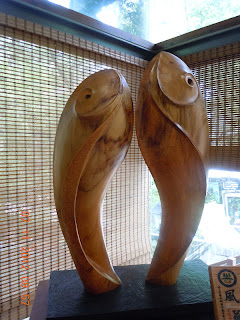Man, it has been awhile since I posted last. We've been on the road for almost two weeks now and tomorrow we will head back to Taipei. This post will include everything that has happened within the last six days, so get ready to read! :)
Thursday we left Shueili and headed to the Endemic Species Research Institute. Before touring the Institute we had a brief introduction on how to prepare avian specimens for research. You can choose to preserve the whole specimen or just keep the skeleton. If you only want the skeleton you have to remove the bird’s feathers, skin, and muscle and let it soak in hydrogen peroxide for at least two days, then you will be left with the skeleton. If you want to preserve the whole bird just taxidermy it. After the introduction we got to go into the specimen room to see the preserved birds and mammals.


We then learned about the Wildlife First Aid Station. Their main objectives are to rescue, restore and release wildlife. Birds account for 80% of the rescues, mammals account for 15% and reptiles account for 5%. They also rescue raptors and have found that 57% of them are injured by cars, 30% by mist nets, and the rest by leg hold traps and toxicosis. We got to tour the Station and saw the examination room, operating room, X-ray room, and some of the rescued birds. We also viewed a short documentary about the unique behavior of the Oriental Honey Buzzard and found out that they feed on bee and hornet pupae, they communicate and attack hornet nests together, and there is equality between the sexes. For example, one day the male might watch the chicks while the female finds food, and then the next day the roles are switched, the male finds the food while the female watches the chicks.



We also had lecture on bats and the lecturer brought in a live one. He let it out of the cage so we could take pictures and it got scared and started flying around the room. Bats are a symbol of good luck and good fortune in the Chinese culture. I learned that there are a total of 1,100 species of bats in the world and 35 species live in Taiwan. They include the Formosan Flying Fox, Leaf-nosed Bat, and Taiwanese Wooly Bat. Also, out of the total species of bats in the world, 70% are insectivores and 30% eat pollen and fruit. We also got to tour the Conservation EducationCenter and saw an exhibition on moths and learned about the different ecosystems of the island.



Friday we woke up at the Phoenix Tea Farm and took a short tour of the place. Then we got to learn the art of tea brewing. This was a very cool experience and I would love to get a tea set and bring it back home so I can teach my family. Oh and I also found out that you can get drunk off of tea! We brewed Dongding Oolong Tea, Oriental Beauty, and another one that was very expensive but I don’t remember its name. I do remember why it is so expensive though, this tea is grown at high elevation and high elevation tea is more difficult to obtain, therefore it is more expensive.




After tea brewing we went to Bamboola Taiwan which produces expensive products made out of bamboo. Some of their more interesting products are trick boxes. While we were there we spent most of our time trying to open them. After Bamboola we headed to XitouExperimental Forestand had an introductory lecture on the place. Xitou was established in 1902 and covers 32,781 hectares. It includes five forest types from 220 meters up to 3,952 meters; they even have an observatory! I envisioned the place to be out in the middle of no where, with no tourists, but when we got here I saw that I was totally wrong. They are everywhere! I also learned that they installed a 40 meter high CO2 Flux Tower to monitor their tree plantation.



Saturday morning we had a lecture on tea science and got to experience the aromas of three different teas. An interesting fact I learned from this lecture is that black tea isn’t really black, it’s red. After lunch we had a brief lecture on the birds of Taiwanand then we went to take a tour of Xitou. There was a point where I thought T-Rex and some velociraptors were going to come out of the bushes because all of the tree ferns made it look like JurassicPark. And ironically, after observing the area, we decided to do our research project on the tree ferns. To finish out the night we finalized our project proposal.
Sunday we had lecture on soil biodiversity. I enjoyed this lecture because I took a soil science class last Fall so I already knew the information, thank you Dr. Hallmark! Also, in the lecture there were some references to molds and mushrooms used as food (Cordyceps) and used to produce food (soy sauce). I already knew about them because Dr. Shaw did an awesome job teaching us about ‘shrooms in BESC 204. The lecture also talked about Aspergillus and Trichoderma which I learned about in Plant Pathology. Next we had a lecture on general biodiversity by Dr. Tom. This was a cool lecture because we got to have it outside.
Yesterday we woke up and began collecting data for our research project. Our first collection site was the Bird Watching Trail. Along the trail we recorded every Taiwan tree fern and Common tree fern we could see. I took a soil sample from a healthy tree fern and a dead tree fern and Heng-An and Anbo took GPS coordinates for each tree fern. We saw a lot of birds on the way and we hiked up over 800 steps! By the time we finished the trail it was lunch time so we took a break and then headed to our second collection site, the Fern Arboretum. It started raining half way through our data collection, but we kept going because we did not want to have to finish it Tuesday. Between the two sites we recorded a little over three hundred tree ferns.



Today we got up and hiked the Riverside Trail to get to the Giant Tree. I thought it was going to be like a Redwood from California, but when we got there it was a total disappointment. The dang tree was dead! But we still got a picture in front of it. Then we walked down the Giant Tree Logging road to the Skywalk. This was pretty cool and it felt like we were floating through the tree canopy. After the Skywalk we walked the Quiet Trail to University Pond and got some delicious ice cream and a sausage on a stick. We took the University Pond Trail to get back to the hotel for lunch. After lunch we had to test the pH of the soil we collected yesterday for our project. Then we went to MonsterVillage and spent almost two hours there, we had fun and laughed a lot.




















































